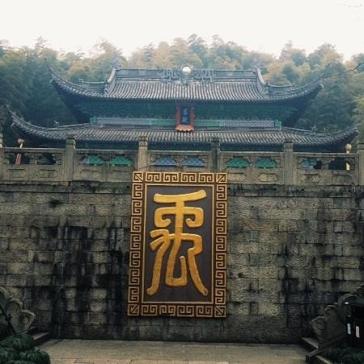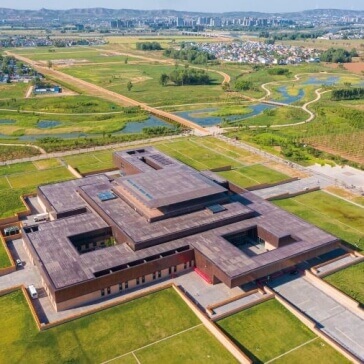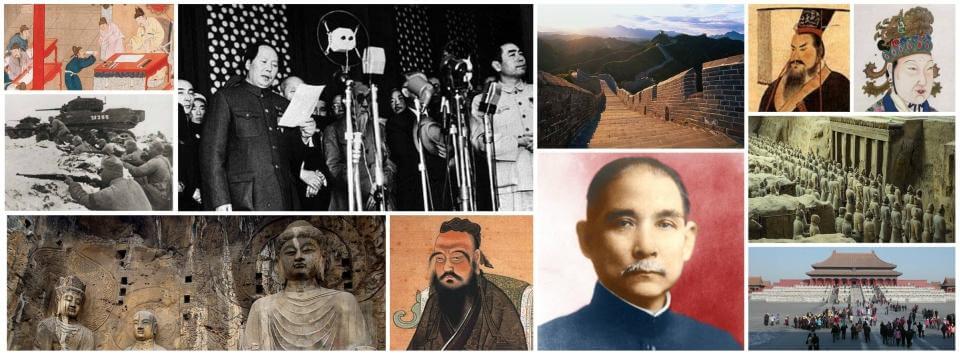
Xia Dynasty (ca. 2100 – ca. 1600 BC)
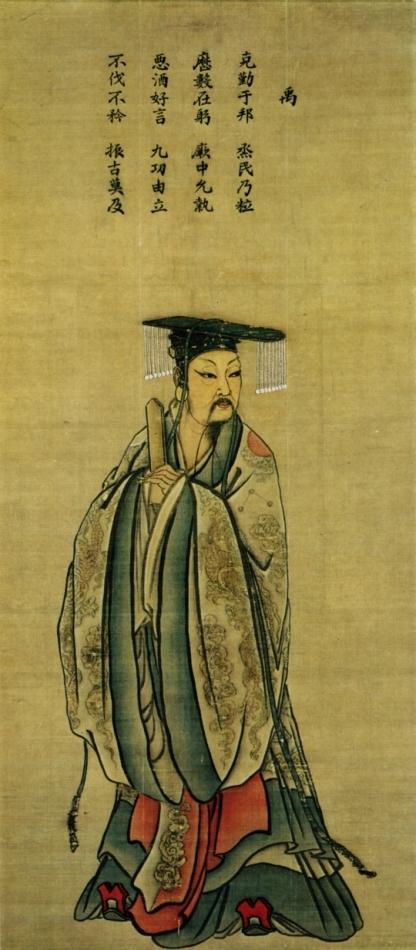 Yu the Great (King Yu) as imagined by the Song dynasty painter Ma LinAbout 4,000 years ago, the area that is now China entered a transitional period. The early cultures that are mentioned in the previous section on this website continued to produce pottery for as long as their societies existed. Additionally, a primitive metallurgical industry slowly started to develop. People began to mine copper, tin and other metals and a smelting technology developed that led to the creation of bronze sometime around the year 2000 BC.
Yu the Great (King Yu) as imagined by the Song dynasty painter Ma LinAbout 4,000 years ago, the area that is now China entered a transitional period. The early cultures that are mentioned in the previous section on this website continued to produce pottery for as long as their societies existed. Additionally, a primitive metallurgical industry slowly started to develop. People began to mine copper, tin and other metals and a smelting technology developed that led to the creation of bronze sometime around the year 2000 BC.
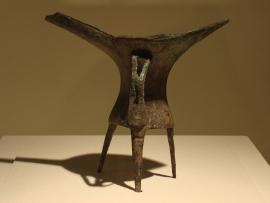 Bronze Jue (wine-drinking vessel), Xia dynasty, Erlitou cultureThis strong and durable material was used to create tools as well as weapons and even beautiful objects of spiritual significance. This development marks the beginning of the first real historical state in Chinese history - the Xia state - that we can not only study through its archeological remnants but also from written records. However, the Xia dynasty is unique in Chinese history in that we don't possess actual written texts from the Xia itself but can only study texts that were written in later periods that mention the Xia. So, most of what we know today about the Xia is a projection back in time from what we know about the succeeding dynasty, the Shang dynasty, as well as from important historical documents such as the Book of Documents (that is known by different names in Chinese such as Shu Jing, Shu King or Shangshu), the Bamboo Annals and Sima Qian's Records of the Grand Historian (in Chinese, it is known as Shiji). English translations of all three historical works can be found online. The Book of Documents can be read online on this page, the Bamboo Annals are available here and the Records of the Grand Historian can be read here. The latter is a historical chronology that spans a period of about 2,500 years. It was written by the famous historian Sima Qian.
Bronze Jue (wine-drinking vessel), Xia dynasty, Erlitou cultureThis strong and durable material was used to create tools as well as weapons and even beautiful objects of spiritual significance. This development marks the beginning of the first real historical state in Chinese history - the Xia state - that we can not only study through its archeological remnants but also from written records. However, the Xia dynasty is unique in Chinese history in that we don't possess actual written texts from the Xia itself but can only study texts that were written in later periods that mention the Xia. So, most of what we know today about the Xia is a projection back in time from what we know about the succeeding dynasty, the Shang dynasty, as well as from important historical documents such as the Book of Documents (that is known by different names in Chinese such as Shu Jing, Shu King or Shangshu), the Bamboo Annals and Sima Qian's Records of the Grand Historian (in Chinese, it is known as Shiji). English translations of all three historical works can be found online. The Book of Documents can be read online on this page, the Bamboo Annals are available here and the Records of the Grand Historian can be read here. The latter is a historical chronology that spans a period of about 2,500 years. It was written by the famous historian Sima Qian.
However, since no contemporary historical records from the time of the Xia dynasty itself have so far been uncovered, some experts still regard this dynasty as merely mythical. Even if the Xia dynasty really existed (and new evidence keeps turning up that affirms this notion), it is at this time impossible to precisely date its beginning and end. In any case, one highly significant figure that is mentioned in the Book of Documents as well as in the Records of the Grand Historian is the legendary Yu the Great (ca. 2200 BC - ca. 2100 BC). In the English translation of the Records of the Grand Historian that is linked above, the Chinese name of Yu the Great has been translated as Emperor Yii and the Xia dynasty has been transcribed as the Hsia dynasty. In the translation of the Book of Documents, Yu the Great is referred to as the Great Yü. According to the documents, Yu the Great was the founder of the Xia dynasty. This first dynasty in China's history also set the precedent for China's hereditary system of succession when Yu's son Qi took over the throne after a three-year mourning period after Yu's death. Interestingly, that came about even though Yu the Great did not want his son to become the next ruler. Nevertheless, the hereditary system of succession would henceforth continue for thousands of years until the end of the Qing dynasty.
Yu the Great died from an illness during a hunting tour in the environs of Kuaiji Mountain and was reportedly buried there. In the 6th century AD, a temple and mausoleum were built in his honor at the foot of the mountain there, south of where the city of Shaoxing (Zhejiang province) is now located. This Yu Temple and Mausoleum of Yu the Great where several emperors performed sacrificial rites in Yu's honor during imperial times are now popular tourist attractions.
Yu Temple & Dayu Mausoleum
The Yu Temple and the Mausoleum of Yu the Great (a.k.a. Dayu Mausoleum) are located inside Shaoxing's Kuaiji Mountain Scenic Area. There are several other sights within this verdant scenic area that also merit a visit such as the Da Yu Memorial Hall, Yu Clan Temple, Jiyu Square and the Jiyu Pavilion, the Great Yu Statue on Shifan Hill and the Lufeng Temple on Mount Xianglu.
Click here to learn more!Opening Hours
8am - 5pm
Entrance Ticket Prices
50 yuan
Free for children under 1.2m and half price for children between 1.2m and 1.5m
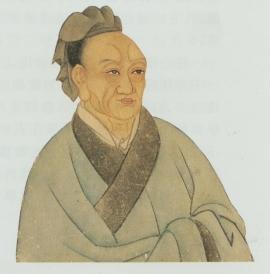 Portrait of Sima QianUnfortunately, no contemporary historical proof for the existence of Yu the Great has so far been uncovered. The oldest archeological evidence that such a person existed comes from inscriptions on a bronze ding vessel (that has therefore been named the "Da Yu ding") that was made about a thousand years after Yu's supposed death. According to Sima Qian's Records of the Grand Historian which mentions many of the stories that deal with Yu's legendary accomplishments, Yu was in charge of and personally worked on the implementation of flood control measures along the Yellow River, Wei River and other waterways. These measures included the time-consuming building of irrigation canals and the dredging of riverbeds. Yu the Great is still revered in China today for his success in implementing these measures. During the 13 years he spent controlling the floods (which followed a period of about 9 years when Yu's father Gun unsuccessfully tried to reign in the floods), he reportedly passed by the gate of his own house three times without taking some time off his duties to enter and visit his wife. In the minds of many Chinese people, that anecdote exemplifies Yu's unwavering dedication to his duties and concern for the common people of his Xia dynasty state.
Portrait of Sima QianUnfortunately, no contemporary historical proof for the existence of Yu the Great has so far been uncovered. The oldest archeological evidence that such a person existed comes from inscriptions on a bronze ding vessel (that has therefore been named the "Da Yu ding") that was made about a thousand years after Yu's supposed death. According to Sima Qian's Records of the Grand Historian which mentions many of the stories that deal with Yu's legendary accomplishments, Yu was in charge of and personally worked on the implementation of flood control measures along the Yellow River, Wei River and other waterways. These measures included the time-consuming building of irrigation canals and the dredging of riverbeds. Yu the Great is still revered in China today for his success in implementing these measures. During the 13 years he spent controlling the floods (which followed a period of about 9 years when Yu's father Gun unsuccessfully tried to reign in the floods), he reportedly passed by the gate of his own house three times without taking some time off his duties to enter and visit his wife. In the minds of many Chinese people, that anecdote exemplifies Yu's unwavering dedication to his duties and concern for the common people of his Xia dynasty state.
For a long time, historians couldn't find any evidence for the occurrence of large-scale floods during the period of the Xia dynasty though. The first such evidence was discovered recently on the upper reaches of the Yellow River. According to this scientific paper, a powerful earthquake that occurred around 1920 BC may have triggered a large outburst flood from a lake that had formed over 6 - 9 months after a large landslide had blocked the course of the Yellow River in this region. According to the researchers, the water control problems that resulted from this initial flooding could have lasted for about two decades. If that was indeed the case, it would support the story of Yu the Great and his father Gun being occupied with taming the floods for such a long period. However, the supposed time when this flood occurred is about 200 years after Yu is presumed to have died.
Another important development that occurred during the period of the Xia dynasty was the building of large palace forms of architecture. They were built on rammed earth platforms where wooden frames were filled with earth and then rammed down with flat stones to create a firm, compressed layer. The process was then repeated to create layer upon layer until it reached the desired height. The emergence of this new type of architecture during the Xia period was a significant change compared to earlier methods of construction and over time became characteristic of urban places in Chinese history.
 Left: Drawing of a Xia dynasty palace Right: Drawing of the Erlitou Palace
Left: Drawing of a Xia dynasty palace Right: Drawing of the Erlitou Palace
The most striking of these early palace complexes was discovered at a site called Erlitou in the western part of modern-day Henan province. Many scholars have therefore concluded that the Erlitou Site was the capital of the Xia dynasty. However, that conclusion is still widely disputed and some scholars even see the Erlitou culture as totally separate from the Xia dynasty state.
The palatial buildings at the Erlitou Site used a post and beam architecture where upright posts were erected on rammed earth platforms. Beams were then placed on top of these posts and a roof was built over these structures. This kind of architecture used a minimal amount of timber, which was a scarce resource in North China. By using a post and beam system, fairly large interior spaces could be created which were perfectly suited as places of worship as well as for political activities. The walls of the structures were filled with wattle and daub, woven organic fibers that were then plastered with mud. The resulting walls were very light and therefore didn't have to carry a lot of weight (which was carried by the posts).
The excavated Erlitou Site has been made accessible to the public inside the Erlitou Archaeological Site Park and many of the ancient relics that were unearthed there can now be seen inside the modern Erlitou Relic Museum nearby.
Erlitou Site & Relic Museum
China's earliest palace complex was excavated at the Erlitou Site near Luoyang (Henan province). This ancient site which was inhabited from about 1900 BC until about 1500 BC is believed to have been the middle to late-stage capital of the Xia dynasty. Thousands of the unearthed Erlitou culture relics can be seen at the modern Erlitou Relic Museum that was opened to the south of the site in 2019.
Click here to learn more!Opening Hours
9am - 5pm
(no entry after 4pm)
closed on Mondays
Entrance Ticket Prices
Free
visitors must present valid ID
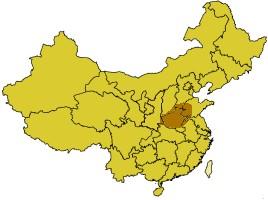 Location of the Xia dynasty stateOf course, it was the ruling elite who used these new palace structures for ritual and ceremonial purposes or other public functions whereas ordinary people continued to live in the partially excavated structures that are characteristic of earlier periods. This development of a social hierarchy was only possible through productivity increases in agriculture. For the first time, there was an agricultural surplus (of grain) and that allowed some people in society to concentrate on other tasks instead of farming. Therefore, artisans, craftsmen, warriors and spiritual as well as political leaders began to appear in society.
Location of the Xia dynasty stateOf course, it was the ruling elite who used these new palace structures for ritual and ceremonial purposes or other public functions whereas ordinary people continued to live in the partially excavated structures that are characteristic of earlier periods. This development of a social hierarchy was only possible through productivity increases in agriculture. For the first time, there was an agricultural surplus (of grain) and that allowed some people in society to concentrate on other tasks instead of farming. Therefore, artisans, craftsmen, warriors and spiritual as well as political leaders began to appear in society.
These newly emerging political elites used these large-scale palace structures for public activities that were designed to legitimize their leadership. The performance of certain spiritual practices helped them to achieve this goal. Whereas earlier cultures in China engaged in totemism, a form of shamanism where animal spirits were associated with particular tribal or clan or family groups, it was during this period that the worship of the totems of one particular family developed into a royal ancestral cult. From then on, the ancestors of the current rulers were seen as divine powers who could affect life in the present world. The rulers seem to have performed public sacrifices to commemorate their ancestors and they seem to have performed rituals in which they asked the ancestors for help and advice regarding current problems of their world.
The story of how the Xia dynasty came to a violent end and was replaced by the Shang dynasty is told in the next section of Chinese History Digest's summary of China's history. We know a lot more about the Shang dynasty than about the Xia because it is the first of China's imperial dynasties of which written records exist.
